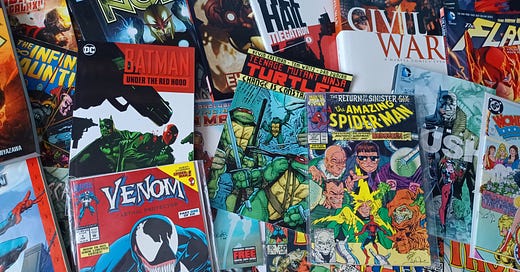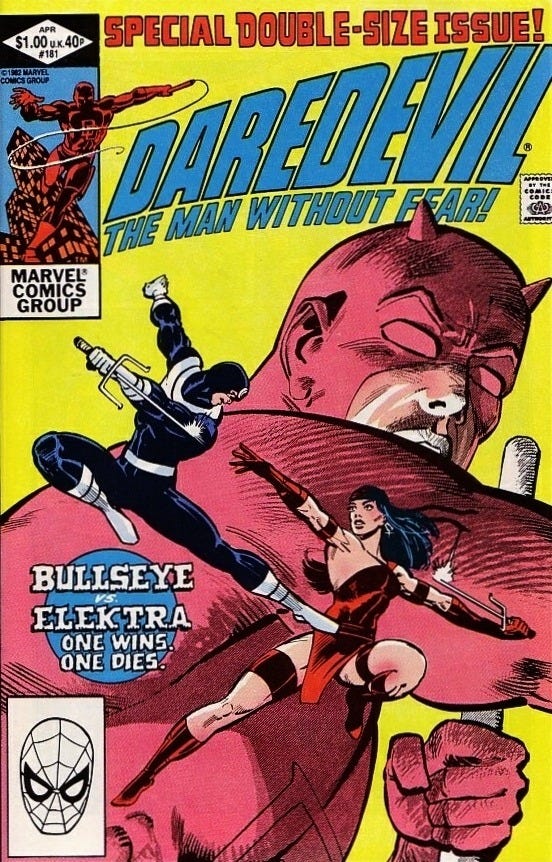A Reader's Guide to Comic Books
Getting into comic books can be confusing, so I'm going to try and make it as painless and simple to understand as possible for you to make your start!
Comics are a wonderous medium with fantastical stories and astounding art. But, unlike mangas, finding where to start with comics can seem daunting and convoluted. With numerous runs, reboots, and rebirths it seems intimidating on where to start exactly. With mangas it’s easy; you just start at volume 1. Wanna read Dragon Ball? Volume 1. Ghost in the Shell? Volume 1. Akira? Well, there’s only one giant collection for that, so that’s easy. But with Marvel, DC Comics, IDW, Dark Horse, Image, Top Cow etc. with over 85 years of stories to pick out from it’s hard to make a start.
Or maybe, it’s not that hard.
Research & Resources.
Getting into a new hobby shouldn’t feel like homework, but education can be fun. Researching into what you want to read will help in the long run and will help you dig out what stories to read (and what ones to avoid because there’s some real stinkers out there *cough modern Amazing Spider-Man cough-cough*). All you need to do is start somewhere, pick what’s most interesting to you, and the rest will unfold.
So, let’s say you want to start reading Daredevil. There’s 61 years of stories there and several points to start off. But fear not! Let’s do our research and find out where we can start.
Now, one of the absolute easiest and bare bones starts you can make to picking up your first comic is judging a book by its cover. “But you’re not supposed to do that!” Shh! You have every right to with a comic book! Because that’s how it attracts you. Most all comic issue covers have something dynamic going on hinting at what goes on inside the issue and there are many legendary covers around. Hell, some collectors get issues based on covers alone. So if one cover catches your eye and interest, go for it!
But to get into the more studious aspects of getting into comics, there are sites to make things easier for you. One of the best places to learn of any comic character or comic run is Comicvine, an extensive wiki and forum on damn near every character and comic from the most popular to the most obscure. Marvel and DC Comics have their own wiki’s as well that are more specific, but ComicVine is much broader.
Looking up a character on the site, for example ol’ horn head’s, you’ll see details on his character such as name and aliases, creators, first issue appearance, death (or deaths if you’re an X-Man), publisher, number of issues appeared in, and powers. There is also a vast rundown and summary of his publication history detailing key stories and use in other media.
Handily at the top of the page are pages of comic runs he has appeared in and the number of times. These provide you with what series are available.

Looking at DD’s original Daredevil series shows every single comic issue (floppy) ever released, complete with dates for that series. Looking at any one issue gives you a summary of the issue as well as creators credited, characters appearing, and community rating. Additionally it’ll show you variant covers of any available.
On each comic series page they also list collected trade paperbacks (TPB’s) collecting single issues of a story arc into one complete book. As you will see on Daredevil’s page there are many. Some collect whole stories, but also some collect based on complete writer’s and/or artist’s work. For example there are 3 volumes of Frank Miller’s and Klaus Janson’s Daredevil run, or in one complete omnibus of everything in those 3 volumes. Generally, TPB’s collect 5 issues at minimum or 15 issues at maximum per volume while omnibuses collect 30+. They’re hefty tomes.
Which leads me to my next point: over a comic’s lifespan many artists and writers come in on rotation. Some will come in for 50 issues, another will come in for 10, and another after that for 100. It all varies for how long they were signed on for at the time. As you can see on Daredevil’s page it lists nicely every creator who has worked on the series and what number of issues they had worked on. Using Frank Miller again, he worked on issues #165-166, 168-191, 219, and 226-233, all of which are collected in the previously mentioned volumes and omnibus. Handy, right?
But how do you pick which creator run to go for? Well, there’s a couple of ways to go about it.
There are recommended reading lists you can easily google that point you in the right direction.
Read through the wiki page, see which story takes your fancy, find who did that run, and go from there.
Reading up on a creator.
Research what collected volumes cover what story.
Ask. Ask a friend who knows comics, or forums on ComicVine or even reddit, or even a comic retailer.
Ok, so that’s not a couple of ways, that’s a quintuple of ways. But those are some key ways to find where to start, and you are intuitive enough to get this figured out. I would personally suggest Frank Miller’s run on Daredevil is the ideal place to start as that inspired both the Daredevil film and the MCU Daredevil series heavily. That is if you want to start somewhere familiar and at the character’s most popular point to get right into the action. Otherwise there have been numerous Daredevil runs worth checking out that are highly well recieved; Brian Michael Bendis, Chip Zdarsky, Mark Waid, Kevin Smith, and Ann Nocenti.
If you want to start from the very beginning of a character or team, Marvel has great Masterwork collections which collect issues of a series from the very start. Just start with Marvel Masterworks Volume 1, and they’re still running continuously today, as Fantastic Four and Amazing Spider-Man are both currently on their 26th volumes. There are Masterwork collections for almost all Marvel characters and teams; Captain America, Iron Man, The Avengers, X-Men, Thor, The Incredible Hulk, and even Ant-Man. The Masterwork volumes are as close to manga collectionss as we will get as it is just pick up volume 1 and go.
There are other comic series that are extremely easy to start to get into. For example, Invincible has a collection select TPB’s or in giant omnibuses collecting upward of 50 issues each. IDW’s Teenage Mutant Ninja Turtles has collections of their 2011 reboot as well as Eastman & Laird’s classic original run. Dark Horse also has Hellboy collected in simple omnibuses. Grab volume 1 of any of these and you’re on your way.
Start Reading
So now you have a pretty good idea on what comics are available, you’ve narrowed down what’s available to which comic you want to read, but where do you go? There are two ways to go with it; print or digital.
With print, you can hunt down floppies of single issues, which will be bagged and boarded for protection. Certain older issues will be very expensive but you will find a vast majority will be very affordable. For collection’s sake, storage for floppies will be kept in comic boxes, long white boxes that come usually in cardboard but can come in plastic. As previously covered, you can of course get your TPB’s and omnibuses. So, if you want a contained book, TPB. If you want a comic in its original release and singular experience, floppy. Whichever you choose that is your discretion.
To buy comics, you can find a local retailer or search up on eBay. In the UK there are numerous reliable comic retailers such as A Place In Space, Forbidden Planet, and Ace Comics. Waterstones also has a handsome collection of comics and manga, although they call them Graphic Novels because they’re much too shy to call them what they are— comic books. A graphic novel is a type of comic book. For example, Frank Miller’s 300 is a graphic novel as it is a type of comic told in a singular story within the comic book medium. Anyway, in the US you have a much easier time finding stores as over here in the UK it’s still pretty niche even after all these years. Handily, DC Comics has a store locator on their site. So if one’s local to you, go hit them up. However, it doesn’t list all available comic book shops, so you would have to hit up Google Maps for any others in your area.
Amazon also has Comixology to read comics online on their library and on Kindle, so you can read them on desktop, your phone, or tablet. They frequently have sales going on, so you can grab some collected volumes and omnibuses (omnibi?) for very reasonable prices. With their subscription service Kindle Unlimited you can also read for “free” a select number of comic books, mostly all volume 1's and iconic stories giving you an even greater start. As such, with most comics purchased on Amazon you have the option to buy and read digitally or in print buying from its select sellers.
On Marvel’s website, they have a subscription service with Marvel Unlimited enabling you to read over 30,000 comics on their app with a 7 day free trial. DC meanwhile has their DC Universe Infinite app to read their comics. IDW also has their own app.
Now, you didn’t hear it from me, and you certainly aren’t reading it in these words here either, but there are places where you can read a comic online on certain other sites without paying a penny. But like I said, you didn’t read it amongst these English language words, you understand me?
And Now You’re Set
So now you should understand these simple things about comics:
Where the wikis are to do your research.
Where you can buy and read comics.
What series and runs to read.
Your vernacular; single issues = floppies. trade paperbacks = TPB’s = collections of single issues and stories. Omnibus = bigger collection of issues. Graphic novel = a type of comic book.
And that’s it. That’s all you need to know. And with all I have taught you here, you’re now free to find your own pathways into comic books and learn new things. There are even some things I’ve left out which you will be able to learn on your own. You’re smart enough, I’m not gonna hold your hand and tell you everything.
There’s never been a better time to get into comic books with the rise of so many comic book properties exploding. Thankfully comics are reasonably affordable and if they’re not, well, you know where to look— but remember, I didn’t say a thing about it!
So have fun educating yourself in this new hobby of yours and enjoy the wonderful world of comics!






